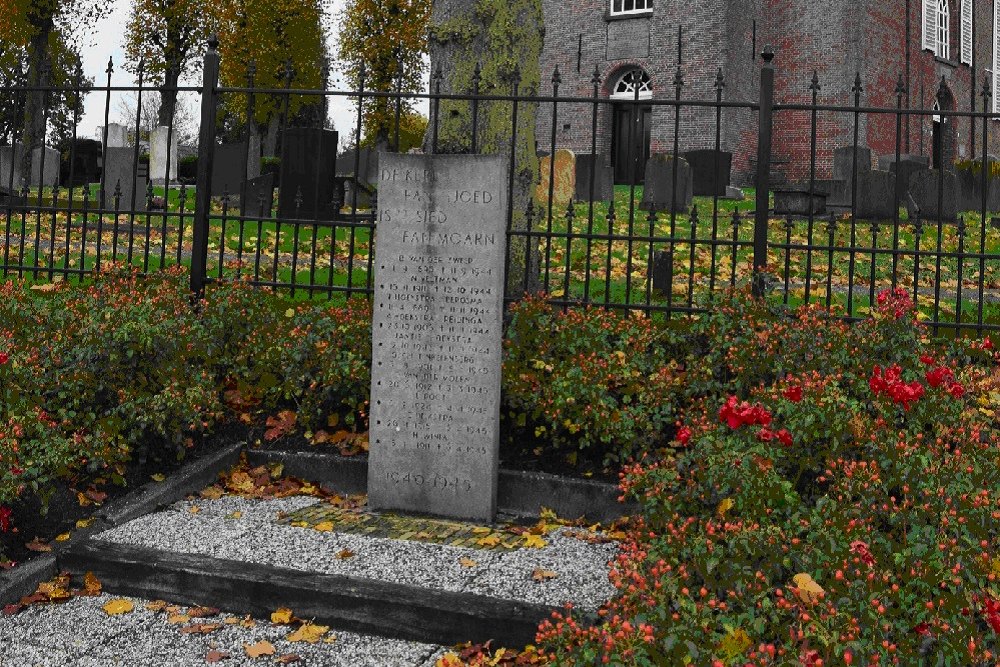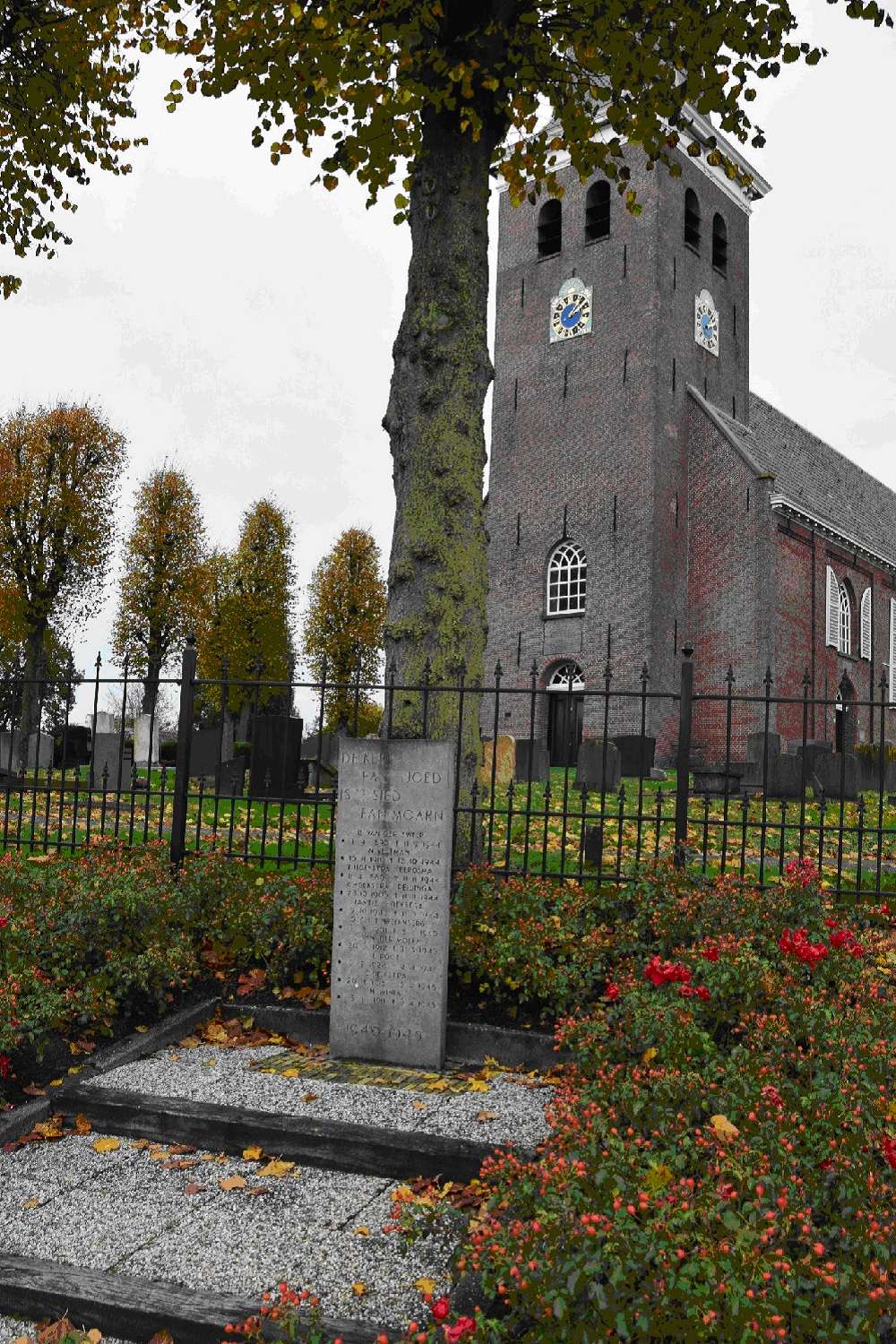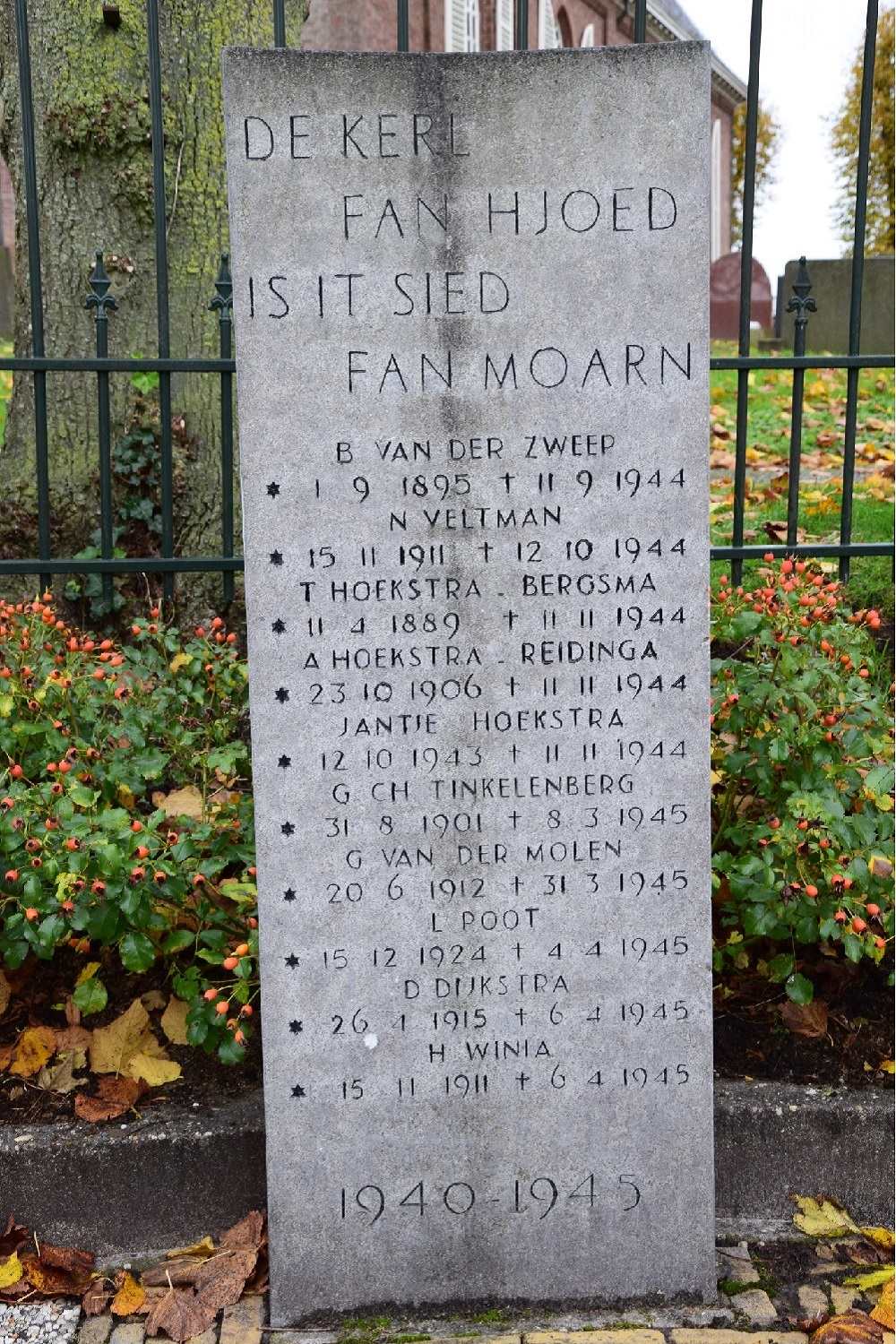War Memorial Raerd
War Memorial Reard (Average Súdwest Fryslân)
The monument at the N.H. church in Raerd (municipality of Súdwest-Fryslân) was erected in memory of ten fellow citizens who died during the occupation years as a result of acts of war.
The names of the ten victims are:
Durk Dijkstra, Jantje Hoekstra, T. Hoekstra-Bergsma, A. Hoekstra-Reidinga, Geert van der Molen, Leendert Poot, George Christiaan Tinkelenberg, Nicolaas Veltman, Herre Winia and Beint van der Zweep.
Durk Dijkstra was born on April 26, 1915 in Terzol. He was a greengrocer. Dijkstra played an active role in the resistance, especially in the transport and concealment of dropped weapons. On March 29, 1945, he was arrested at his home by the Grüne Polizei from Sneek, together with his person in hiding Herre Winia. When they were interrogated in Sneek, it turned out that the occupier was aware of the resistance organization in that area. The next day, the occupying forces completely destroyed the interior of Dijkstra's house with a hand grenade. Mrs Dijkstra and the children had already been housed elsewhere by then. A week before the liberation on April 6, 1945, Dijkstra was transported with Winia to Gaasterland, where they were executed with three other prisoners at the Zandvoorderhoek near the IJsselmeer. Dijkstra was reburied in October 1946 at the NH cemetery in Terzol. A street in this village is also named after him.
Mrs. T. Hoekstra-Bergsma, Mrs. A. Hoekstra-Reidinga (born 23-10-1906) and her daughter Jantje Hoekstra were killed in a bombing raid on 11 November 1944. On that day, the Terhornster Sluis was closed at 9.05 in the morning. bombed by seven Hawker 'Typhoon' bombers from No. 438 Royal Canadian Air Force Squadron, led by Squadron Leader R.F. Reid and eight "Typhoons" from No. 439 RCAF Squadron, led by Flight Lieutenant J.E. Hogg. The machines had a 454 kg bomb under each wing. They were escorted by four 'Thyphoons' from No. 440 RCAF Squadron and preceded by four aircraft from No. 168 RAF Squadron. When the first wave of bombers arrived at the locks, the aircraft started a dive in pairs. The bombs were dropped in series of two. About fifteen minutes later the second wave arrived. When the dust had settled, it turned out that the western lock was still intact. The eastern lock was destroyed, as well as the two lockkeepers' houses. There were four victims: Mrs. T. Hoekstra-Bergsma (born 11-05-1889), Mrs. A. Hoekstra-Reidinga (born 23-10-1906) and her daughter Jantje Hoekstra (born 12-10-1943). and a German soldier.
Geert van der Molen was born on June 20, 1912 in Nijega. As a municipal road worker, he ran the risk of being arrested every day in connection with the deployment of labour. That is why Van der Molen decided to go into hiding. He was an employee of a resistance organization, for which he transported weapons, among other things. On March 31, 1945, when he was transporting a barge with beets, he was shelled by allied aircraft near the Boksumerdam. He was seriously injured and died that same night. Van der Molen was buried at the N.H. cemetery in Poppingawier.
Leendert Poot was born on December 15, 1924 in Delft. He lived in Naaldwijk and went into hiding with cattle farmer A.K. de Boer in Terzol. On April 4, 1945, the farm was surrounded by the occupying forces. Poot tried to reach his hideout in the barn, but he was discovered. When he was taken away after an interrogation in the living room, he made another attempt to escape. He was shot dead on the spot. His host De Boer had to accompany him to Sneek and was able to return home after a few days. Leendert Poot was buried at the NH cemetery in Terzol and reburied after the liberation at the General cemetery in Naaldwijk.
George Christiaan Tinkelenberg was born on August 31, 1901 in Hoorn. He was a teacher in Zierikzee and became head of the public primary school in Sijbrandaburen. As a former officer of the Dutch army, he was asked to take charge of the 9th district of the Dutch Interior Forces. He carried out his resistance work under the pseudonym 'Schuman'. On February 8, 1945, the Grüne Polizei carried out a raid in the Legeäen (the region between Sneek and Rauwerd), in which six men were arrested, including Tinkelenberg. He was transferred to Crackstate in Heerenveen. On March 8, 1945, he and four other prisoners were shot in reprisal near Dongjum. Tinkelenberg was buried at the N.H. cemetery in Sijbrandaburen. A street in this village is also named after him.
Nicolaas Veltman was born on November 15, 1911 in Wolvega. Together with his wife he had a shop ('Kleine Bazar') in Irnsum. In May 1940 Veltman was in the line of fire on the Grebbeberg. He was made prisoner of war and transferred to a camp in Luckenwalde (Germany). After his imprisonment he returned to Inrsum and joined
Do you have more information about this location? Inform us!
Source
- Text: Haintje Kuipers
- Photos: Haintje Kuipers
Nearby
Museum
Point of interest
- Church Bell Dutch Reformed Church - Akkrum
- Church Tower Hijlaard - Hijlaard
- Plaque People In Hiding Mariakerk Blessum - Blessum
Monument
- Facing Stone People in Hiding - Raerd
- Monument Short Stirling EF347 - Schillaard (Mantgum)
- War Memorial Grouw - Grouw
Cemetery
- Commonwealth War Grave Protestant Cemetery Deersum - Deersum
- Commonwealth War Graves Churchyard Skillaerd - Schillaard (Mantgum)
- Dutch War Graves Municipal Cemetery - Grouw
Remembrance Stone
- Stumbling Stone Leeuwarderkade 21 - Sneek
- Stumbling Stone 2e Oosterkade 9 - Sneek
- Stumbling Stones Parallelweg 21 - Sneek







